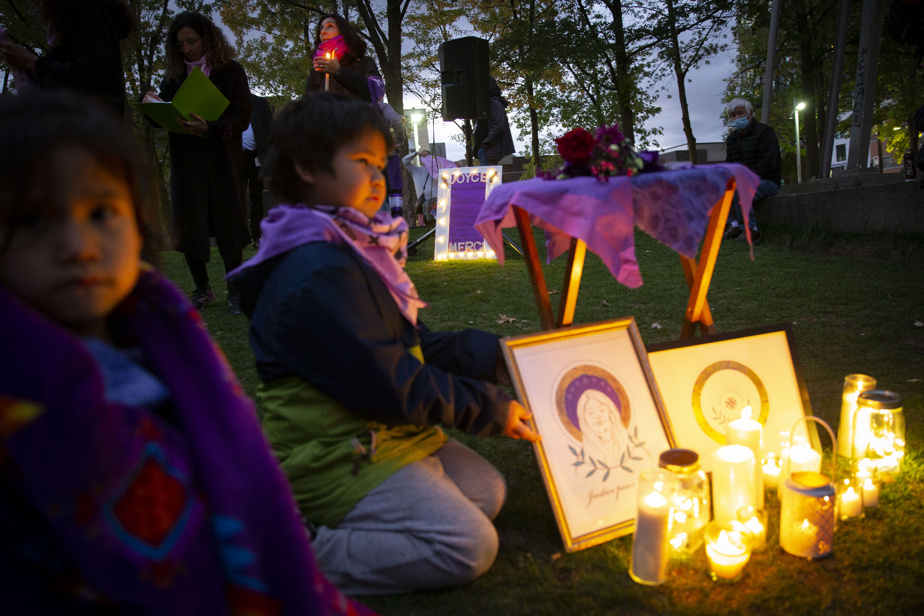(Montreal) A live death under racist insults from nursing staff, this is what Quebec witnessed on September 28, 2020 when Joyce Echaquan found the strength to film the way in which she was treated from her hospital bed . Three years later, this tragic death of an Atikamekw mother of eight children continues to cause changes, but “fear” remains very present among many Indigenous people.
“The fear is still there. She is here. Every week since Joyce’s death, we still see scary situations. Which do not help improve people’s confidence,” observes the general director of the Office of the Joyce Principle, Jennifer Petiquay-Dufresne.
His organization’s mandate includes ensuring that Indigenous people feel safe and are treated without discrimination when they need health care and services. However, despite all the government’s goodwill speeches and the measures put in place to make health personnel aware of Indigenous realities, incidents continue to accumulate.
We still report situations where people are treated with discrimination or not in the fair way they should be treated according to the rules of the art. Then it’s like wildfire. People say it to each other to protect themselves.
Jennifer Petiquay-Dufresne, executive director of the Joyce Principle Office
In her investigation report into the causes and circumstances of the death of Joyce Echaquan, coroner Géhane Kamel concluded in September 2021 that “racism and prejudice […] were certainly contributory to his death.”
Officially, Mme Echaquan, 37, died of pulmonary edema, likely caused by cardiomyopathy. She had been admitted by ambulance the day before to the Lanaudière Regional Hospital Center for acute gastric pain. Staff then falsely labeled her, due to racial bias, as a drug addict in withdrawal when there was no clinical evidence to support this.
Despite this damning report from the Coroner’s Office, the Quebec government stubbornly refuses to recognize the existence of systemic racism in the health network as elsewhere in the province. At the same time, he opposes the adoption of the Joyce Principle, which requires recognition of this state of affairs and a commitment to providing safe and non-discriminatory access to health care for people of indigenous origin.
This refusal itself fuels fear, believes the president of Quebec Native Women, Marjolaine Étienne. She believes that “the things we don’t name” tend to continue. “If it continues like this, I dare to hope that another moment like we suffered will not come,” she says.
For this same reason, Jennifer Petiquay-Dufresne judges that “it’s still hot” between Indigenous communities and the health network. A situation that affects women more since, culturally, they are the ones who consult professionals for their children, for their husbands and obviously for themselves.
In the brief submitted by the Office of the Joyce Principle as part of the consultations on the bill establishing the cultural safety approach within the health and social services network, various indigenous health professionals are cited as having to regularly argue to convince their patients to seek care in a hospital.
“My patients fear discrimination, […] to be discredited or even to meet the same fate as Joyce,” reads a quote attributed to an Atikamekw caregiver.
With its Bill 32, the CAQ government is attempting a first step towards cultural security for Indigenous people, but the initiative was received very coldly by representatives of the First Nations and Inuit. The epithets “colonialist”, “paternalist”, “disrespectful” and “insufficient” were used in particular to express dissatisfaction with the content of PL-32 and the way of proceeding by the Minister responsible for Relations with First Nations and Inuit, Ian Lafrenière.
Free the floor
Among the cascade of repercussions caused by the tragic death of Joyce Echaquan at the Lanaudière Regional Hospital Center, also known as the Joliette Hospital, we must include the momentum of mobilization to denounce the forced sterilizations carried out by Quebec doctors against the wishes of indigenous women.
The general director of the First Nations of Quebec and Labrador Health and Social Services Commission (FNQLHSSC), Marjolaine Siouï, says that the movement was already underway at the time of the tragedy, but additional funds quickly came to support the efforts. Then the number of complainants began to climb.
“There, we are in phase two of the research report,” explains M.me If yes. This means that there are even more people who wish to testify. »
According to her, it is obvious that Joyce Echaquan’s live denunciation “gave the courage” to other people to act. Women who had never been taken seriously said to themselves, “I’m going to tell my story again and maybe this time it will have an impact on the system.”
Moreover, last month, the Superior Court of Quebec authorized a class action for “women of Atikamekw origin who underwent a surgical procedure that damaged their fertility without having given their free and informed consent.” The plaintiffs are suing three doctors who practiced at the Integrated Health and Social Services Center of Lanaudière.
Another positive impact will have been the deployment of a network of indigenous health clinics in urban areas, underlines Jennifer Petiquay-Dufresne. She adds that initiatives of this type, coming from communities, could be much more numerous if Quebec took the time to co-construct with the First Nations and the Inuit on any issue that concerns them.
Duty of memory
On the occasion of this third anniversary of the death of Mme Echaquan, all the speakers consulted spoke of the importance of not forgetting. A duty of remembrance for Indigenous and non-Indigenous people.
“It is important to remember the facts, as much for Ms. Joyce Echaquan as for the family, for Atikamekw women and for the Atikamekw Nation. It’s still painful,” insists Marjolaine Étienne.
The Canadian Press’ health content receives funding through a partnership with the Canadian Medical Association. The Canadian Press is solely responsible for editorial choices.
